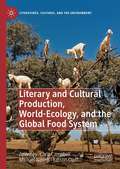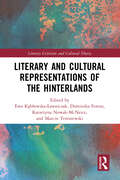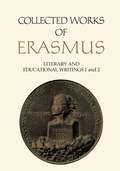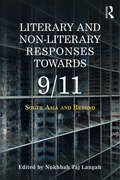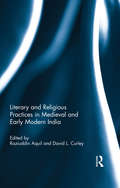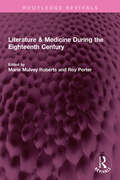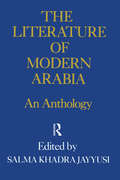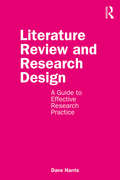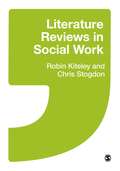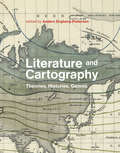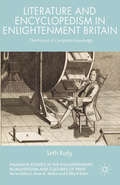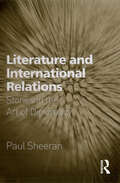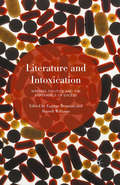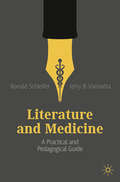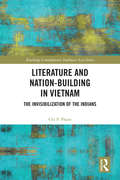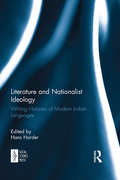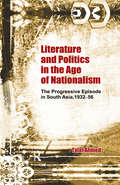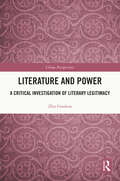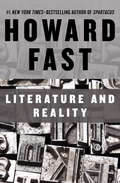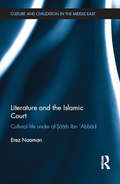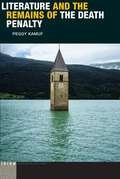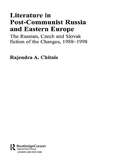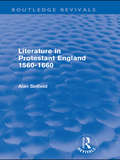- Table View
- List View
Literary and Cultural Production, World-Ecology, and the Global Food System (Literatures, Cultures, and the Environment)
by Chris Campbell Michael Niblett Kerstin OloffLiterary and Cultural Production, World-Ecology, and the Global Food System marks a significant intervention into the field of literary food studies. Drawing on new work in world literature, cultural studies, and environmental studies, the essays gathered here explore how literary and cultural texts have represented and responded to the global food system from the late nineteenth century to the present day. Covering topics such as the impact of colonial monocultures and industrial agriculture, enclosure and the loss of the commons, the meatification of diets, the toxification of landscapes, and the consequences of climate breakdown, the volume ranges across the globe, from Thailand to Brazil, Cyprus to the Caribbean. Whether it is anxieties over imported meat in late Victorian Britain, labour struggles on Guatemalan banana plantations, or food dependency in Puerto Rico, the contributors to this volume show how fiction, poetry, drama, film, and music have critically explored and contributed to food cultures worldwide.
Literary and Cultural Representations of the Hinterlands (Literary Criticism and Cultural Theory)
by Ewa Kębłowska-Ławniczak Dominika Ferens Katarzyna Nowak-McNeice Marcin TereszewskiThis interdisciplinary collection explores the diverse relationships between the frequently ignored and inherently ambiguous hinterlands and their manifestations in literature and culture. Moving away from perspectives that emphasize the marginality of hinterlands and present them as devoid of agency and “cultural currency”, this collection assembles a series of original essays using various modes of engagement to reconceptualize hinterlands and highlight their semiotic complexity. Apart from providing a reassessment of hinterlands in terms of their geocultural significance, this book also explores hinterlands through such concepts as nostalgia, heterotopia, identity formation, habitation, and cognitive mapping, with reference to a wide geographical field. Literary and filmic revisions of familiar hinterlands, such as the Australian outback, Alberta prairie, and Arizona desert, are juxtaposed in this volume with representations of such little-known European hinterlands as Lower Silesia and Ukraine, and the complicated political dimension of First World War internment camps is investigated with regard to Kapuskasing (Ontario). Rural China and the Sussex Downs are examined here as writers’ retreats. Inner-city hinterlands in Haiti, India, Morocco, and urban New Jersey take on new meaning when contrasted with the vast hinterlands of megacities like Johannesburg and Los Angeles. The spectrum of diverse approaches to hinterlands helps to reinforce their multilayered and multivocal nature as spaces that defy clear categorization.
Literary and Educational Writings, 1 and 2: Volume 1: Antibarbari / Parabolae. Volume 2: De copia / De ratione studii (Collected Works of Erasmus #23-24)
by Craig Thompson Desiderius ErasmusThese volumes are the first in a series containing works by Erasmus 'that concern literature and education': interests which to him were scarcely separable. The aim of Erasmian education was a civilized life, expressed in Christian piety and the fulfilment of public and private duties and embellished by learning and literature. Towards these ends the soundest training for youth was what Erasmus often called bonne litterae, 'good letters,' a literary and rhetorical training based on Greek and Latin authors. For centuries the classical curriculum was the core of liberal education, and Erasmus was long regarded as its exemplar. Though never a university teacher except briefly at Cambridge (1311-14), he was a 'teacher of teachers' through his treatises on pedagogy and rhetoric and his many works of scholarship. The four works presented here in annotated translations are characteristic expressions of his dedication to learning and his confidence in the values of classical literature for the modern world of his time. Antibarbari (1520), translated and annotated by Margaret Mann Phillips, is a defence of the humanities against ignorant and misguided critics who question both their supposed worth and the appropriateness of pagan writings for Christian pupils. The reply of Erasmus becomes a manifesto on behalf of reason, scholarship, and literature. As for paganism, he insists that if secular knowledge is used properly it cannot harm but must help Christians. 'None of the liberal disciplines is Christian' because they all antedated Christianity, yet they 'all concern Christ' because they can be put to Christian uses. Parabolae (1514), translated and annotated by R.A.B. Mynors, a work that 'contributes eminently to style,' is a collection of similitudes drawn from observations of men, customs, and nature. Many are culled from Plutarch and Seneca, but for those from Seneca, and from Aristotle, the moral applications are added by Erasmus. As an exercise in the rhetoric of moral philosophy - 'many jewels in one small box,' Erasmus terms it-this book quickly became popular and long remained so. De copia (1512), translated and annotated by Betty I. Knott, is not a plan for the entire curriculum but a treatise on the 'abundant' or rich style in writing and speaking Latin, a guide to attaining fluency and variety in discourse. As a manual for students De copia broke new ground. It was a remarkably successful work, used in schools in many lands for generations. From 1312 to 1600, more than 130 printings are recorded. De ratione studii (1312), translated and annotated by Brian McGregor, furnishes a concise but clear exposition of the curriculum, text, and methods of Erasmus' programme for liberal studies in grammar schools. Here as in all of his writings on education, language is the heart of the matter. The main goals are accurate, effective expression and communication in Latin, though Erasmus expects much besides literature to be learned from the study of literature. He emphasizes the necessity for competent and sympathetic teachers. Each translation is introduced by the translator, and a general introduction by the editor discusses the significance of each of the works, its relation to the others, and its subsequent fortunes. Wallace K. Ferguson provides an introductory essay, 'The Works of Erasmus.' Volumes 23 and 24 of the Collected Works of Erasmus series – Two-volume set.
Literary and Non-literary Responses Towards 9/11: South Asia and Beyond
by Nukhbah Taj LangahThis book presents a range of analytical responses towards 9/11 through a critical review of literary, non-literary and cultural representations. The contributors examine the ways in which this event has shaped and complicated the relationship between various national and religious identities in contemporary world history. Unlike earlier studies on the topic, this work reconciles both eclectic and pragmatic approaches by analyzing the stereotypes of nationhood and identities while also questioning theoretical concepts in the context of the latest political developments. The chapters focus on discourses, themes, imagery and symbolism from across fiction and non-fiction, films, art, music, and political, literary and artistic movements. The volume addresses complexities arising within different local contexts (e.g., Hunza and state development); surveys broader frameworks in South Asia (representations of Muslims in Bollywood films); and gauges international impact (U.S. drone attacks in Islamic countries; treatment meted out to Muslims in Europe). It also connects these with relevant theories (e.g., Orientalism) and policy perspectives (e.g., Patriotic Act). The authors further discuss the consequences for minorities and marginalization, cultural relativism vs. ethnocentrism, the clash of civilizations, fundamentalism, Islamization and post-9/11 ‘Islamophobia’. This book will be useful to scholars and researchers of South Asian literature, Islamic studies, literary criticism, political sociology, anthropology and cultural studies, those in the media and the general reader.
Literary and Religious Practices in Medieval and Early Modern India
by Raziuddin Aquil David L. CurleyCovering the history of medieval and early modern India, from the eighth to the eighteenth centuries, this volume is part of a new series of collections of essays publishing current research on all aspects of polity, society, economy, religion and culture. The thematically organized volumes will particularly serve as a platform for younger scholars to showcase their new research and, thus, reflect current thrusts in the study of the period. Established experts in their specialized fields are also being invited to share their work and provide perspectives. The geographical limits will be historic India, roughly corresponding to modern South Asia and the adjoining regions. Chapters in the current volume cover a wide variety of connected themes of crucial importance to the understanding of literary and historical traditions, religious practices and encounters as well as intermingling of religion and politics over a long period in Indian history. The contributors to the volume comprise some fine historians working from institutions across South Asia, Europe and the United States: Matthew Clark, David Curley, Mridula Jha, Sudeshna Purkayastha, Sandhya Sharma, and Mikko Viitamäki.
Literature & Medicine During the Eighteenth Century (Routledge Revivals)
by Roy Porter Marie Mulvey RobertsFirst published in 1993, Literature & Medicine During the Eighteenth Century analyses the close interplay of medicine and literature by paying special attention to questions of body language and the representation of inner life. Although today, medicine and literature are widely seen as falling on different sides of the ‘two cultures’ divide, this was not so in the eighteenth century when doctors, scientists, writers, and artists formed a well-integrated educated elite. Locke, Smollett and Goldsmith were doctors, and physicians such as Erasmus Darwin doubled as poets. Written by leading historians of medicine and eighteenth-century literary critics, this book uncovers the interconnections between medical and psychological theory and ideas of taste, beauty, and genius. Its contributors explore the rich cultural milieu of the period and investigate the ways in which medicine itself contributed to informing a gendered discourse of the world. This book will be of interest to historians, literary scholars and medical historians.
Literature Of Modern Arabia: An Anthology
by Salma Khadra JayyusiFirst Published in 1988. Routledge is an imprint of Taylor & Francis, an informa company.
Literature Review and Research Design: A Guide to Effective Research Practice
by Dave HarrisDesigning a research project is possibly the most difficult task a dissertation writer faces. It is fraught with uncertainty: what is the best subject? What is the best method? For every answer found, there are often multiple subsequent questions, so it’s easy to get lost in theoretical debates and buried under a mountain of literature. This book looks at literature review in the process of research design, and how to develop a research practice that will build skills in reading and writing about research literature—skills that remain valuable in both academic and professional careers. Literature review is approached as a process of engaging with the discourse of scholarly communities that will help graduate researchers refine, define, and express their own scholarly vision and voice. This orientation on research as an exploratory practice, rather than merely a series of predetermined steps in a systematic method, allows the researcher to deal with the uncertainties and changes that come with learning new ideas and new perspectives. The focus on the practical elements of research design makes this book an invaluable resource for graduate students writing dissertations. Practicing research allows room for experiment, error, and learning, ultimately helping graduate researchers use the literature effectively to build a solid scholarly foundation for their dissertation research project.
Literature Reviews in Social Work
by Christine Stogdon Mr Robin KiteleyThis book will provide you with a clear and accessible guide to the process of conducting a literature review, giving you the skills, confidence and knowledge required to produce your own successful review. Drawing on their wealth of teaching experience, the authors outline best practice in: -Choosing your topic -Effective search strategies -Taking notes -Organising your material -Accurate referencing -Managing the process of writing your literature review -Enhancing evidence-based practice. Trying to complete a literature review, research project or dissertation as part of your social work degree? This book will prove the perfect companion. Robin Kiteley is Lecturer at the University of Huddersfield. Chris Stogdon is a social work educator and practitioner.
Literature and Cartography: Theories, Histories, Genres (The\mit Press Ser.)
by Anders Engberg-PedersenThe relationship of texts and maps, and the mappability of literature, examined from Homer to Houellebecq.Literary authors have frequently called on elements of cartography to ground fictional space, to visualize sites, and to help readers get their bearings in the imaginative world of the text. Today, the convergence of digital mapping and globalization has spurred a cartographic turn in literature. This book gathers leading scholars to consider the relationship of literature and cartography. Generously illustrated with full-color maps and visualizations, it offers the first systematic overview of an emerging approach to the study of literature.The literary map is not merely an illustrative guide but represents a set of relations and tensions that raise questions about representation, fiction, and space. Is literature even mappable? In exploring the cartographic components of literature, the contributors have not only brought literary theory to bear on the map but have also enriched the vocabulary and perspectives of literary studies with cartographic terms. After establishing the theoretical and methodological terrain, they trace important developments in the history of literary cartography, considering topics that include Homer and Joyce, Goethe and the representation of nature, and African cartographies. Finally, they consider cartographic genres that reveal the broader connections between texts and maps, discussing literary map genres in American literature and the coexistence of image and text in early maps. When cartographic aspirations outstripped factual knowledge, mapmakers turned to textual fictions.ContributorsJean-Marc Besse, Bruno Bosteels, Patrick M. Bray, Martin Brückner, Tom Conley, Jörg Dünne, Anders Engberg-Pedersen, John K. Noyes, Ricardo Padrón, Barbara Piatti, Simone Pinet, Clara Rowland, Oliver Simons, Robert Stockhammer, Dominic Thomas, Burkhardt Wolf
Literature and Encyclopedism in Enlightenment Britain: The Pursuit of Complete Knowledge (Palgrave Studies in the Enlightenment, Romanticism and Cultures of Print)
by Seth RudyLiterature and Encyclopedism in Enlightenment Britain tells the story of long-term aspirations to comprehend, record, and disseminate complete knowledge of the world. It draws on a wide range of literary and non-literary works from the early modern era and British Enlightenment.
Literature and International Relations: Stories in the Art of Diplomacy
by Paul SheeranMaking a strong case for the relevance of literary production to understanding international relations, this persuasive volume highlights the potential rewards of developing a methodology to bring literature to bear on a discipline which has tended to neglect fictional sources. Paul Sheeran considers the deep insight that can be gained from the study of key works in fiction and literature to enhance knowledge of the social forces shaping world affairs. While there are numerous relevant works, the author has carefully selected multi-faceted and colourful sources of material to explore developments in contemporary global issues such as the demise of the Soviet Union, the attack on the World Trade Centre, infectious diseases and human conflict. This exciting book enthusiastically breaks new ground and is highly suitable for courses on international relations, cultural studies and literature.
Literature and Intoxication: Writing, Politics and the Experience of Excess
by Eugene Brennan Russell WilliamsThis collection traces the intersection between writing and intoxication, from the literary to the theoretical, exploring a diversity of experiences of excess. Comprising a variety of perspectives, this book offers unique insights into how politics and literature have been shaped by states of intoxication.
Literature and Medicine: A Practical and Pedagogical Guide
by Ronald Schleifer Jerry B. VannattaLiterature and Medicine: A Practical and Pedagogical Guide is designed to introduce narrative medicine in medical humanities courses aimed at pre-medicine undergraduates and medical and healthcare students. With excerpts from short stories, novels, memoirs, and poems, the book guides students on the basic methods and concepts of the study of narrative. The book helps healthcare professionals to build a set of skills and knowledge central to the practice of medicine including an understanding of professionalism, building the patient-physician relationship, ethics of medical practice, the logic of diagnosis, recognizing mistakes in medical practice, and diversity of experience. In addition to analyzing and considering the literary texts, each chapter includes a vignette taken from clinical situations to help define and illustrate the chapter’s theme. Literature and Medicine illustrates the ways that engagement with the humanities in general, and literature in particular, can create better and more fulfilled physicians and caretakers.
Literature and Nation-Building in Vietnam: The Invisibilization of the Indians (Routledge Contemporary Southeast Asia Series)
by Chi P. PhamThis book analyzes why Indians have been made invisible in Vietnamese society and historiography. It argues that their invisibilization originates in the formulaic metaphor Vietnamese nation-makers have used to portray Indians in their quest for national sovereignty and socialism. The book presents a complex view on colonial legacies in Vietnam which suggests that Vietnamese nation-makers associate Indians with colonialism and capitalism, ultimately viewed as "non-socialist" and "non-hegemonic" state structures. Furthermore, the book demonstrates how Vietnamese nation-makers achieve the overriding socialist and independent goal of historically differing Indians from Vietnamese nationalisms whilst simultaneously making them invisible. In addition to primary Vietnamese texts which demonstrate the performativity of language and the Vietnamese traditional belief in writing as a sharp weapon for national and class struggles, the author utilizes interviews with Indians and Vietnamese authorities in charge of managing the Indian population. Bringing to the surface the ways through which Vietnamese intellectuals have invisibilized the Indians for the sake of the visibility of national hegemony and prosperity, this book will be of interest to scholars of Southeast Asian Studies and South Asian Studies, Vietnam Studies, including nation-building, literature, and language.
Literature and Nationalist Ideology: Writing Histories of Modern Indian Languages (Ssp Ser.)
by Hans HarderWriting histories of literature means making selections, passing value judgments, and incorporating or rejecting foregoing traditions. The book argues that in many parts of India, literary histories play an important role in creating a cultural ethos. They are closely linked with nationalism in general and various regional ‘sub-nationalisms’ in particular. The contributors to this volume look at a great variety of aspects of the historiography of modern regional languages of India. Please note: Taylor & Francis does not sell or distribute the Hardback in India, Pakistan, Nepal, Bhutan, Bangladesh and Sri Lanka
Literature and Painting In Quebec
by William J. BergThis unique study explores how Quebec's landscapes have been represented in both literature and visual art throughout the centuries, from the writing of early explorers such as Cartier and Champlain to work by prominent contemporary authors and artists from the province. William J. Berg traces recurrent images and themes within these creations through the most significant periods in the development of a Quebecois identity that was threatened initially by the wilderness and indigenous populations, and later by the dominance of British and American influences.Focusing on the interplay between nature and culture in landscape representation, Literature and Painting in Quebec contends that both have reflected and fashioned the meaning of French-Canadian nationhood. As such, Literature and Painting in Quebec presents a new perspective to approach the notion of national identity, a quest that few groups have engaged in more persistently than the Quebecois.
Literature and Politics in the Age of Nationalism: The Progressive Episode in South Asia, 1932-56
by Talat AhmedThis book aims to provide a historical account of the All-India Progressive Writers’ Association (AIPWA). In a structured narrative, it focuses on the political processes inside India, events and circumstances in South Asia and the debates and literary movements in Europe and the United States to demonstrate how the literary project was specifically informed by literary-political movements. It explores the theorisation of literature and politics that informed progressive writing and argues that the progressive conception of literature, art and politics was closer to the theorisation of two thinkers of whom the writers themselves knew very little – Leon Trotsky and Antonio Gramsci. The book charts the progressive movement’s extension into the cultural arena through the Indian People’s Theatre Association (IPTA) and the deepening of its nation-wide character through a progressive nationalism instilled with left-wing ideology. One of the important aims of the AIPWA project was to advance the development of a popular vernacular based on the demotic language of north India – Hindustani. The book locates this issue within the broader nationalist discussion on the national language. Contrary to what is implied by much of the previous scholarship, the book argues that the progressive movement did survive the ravages of partition and that the progressives maintained organisations in both India and Pakistan. It looks at the short-lived but very colourful history of the PWA in Pakistan, using PWA documents, government records and personal testimonies. Arguing that literary output and cultural production cannot be understood, let alone interpreted, outside the context of the nationalist movement, war, independence and partition, the book presents a narrative that necessarily transcends disciplinary boundaries between literature, politics and history. Supplemented with literary and archival sources and oral testimonies from the members of the movement, it pr
Literature and Power: A Critical Investigation of Literary Legitimacy (China Perspectives)
by Zhu GuohuaWith references to the theoretical framework of Michel Foucault and Pierre Bourdieu, this book offers a critical investigation into such epic issues as the end of art and the inherent laws of literature’s evolution, while conflating the two into one major argumentation. The book proceeds from Hegel's claim of "the end of art" to tackle the universal yet essential problem of literature: its legitimacy in a sociological sense. It invests Bourdieu’s sociological terms -- power, capital, habitus, field, etc. into the study of literature and art while taking on other theoretical enquiries, particularly the Marxist exploration into ideology, as well as aspects of economics and communication studies. This book will be a valuable resource for students and scholars of the sociology of literature, cultural studies, and those with specific interests in Chinese literature, literary and art theory.
Literature and Reality
by Howard FastHoward Fast&’s controversial essay on the proper role of literature, offering insight into his life and worksIn this 1950 essay, Howard Fast argues that all writers have a duty to reflect the truth of the world in their works, particularly regarding social justice. Fast&’s treatise on literary criticism allows for a fuller understanding of his early novels, in which his political beliefs remain inseparable from his writing. Literature and Reality, which Fast wrote around the time of the 1949 Peekskill riots, offers a unique window into his worldview during the mid-twentieth century. This ebook features an illustrated biography of Howard Fast including rare photos from the author&’s estate.
Literature and the Development of Feminist Theory
by Robin Truth GoodmanLiterature and the Development of Feminist Theory offers an insightful look at the development of feminist theory through a literary lens. Stressing the significance of feminism's origins in the European Enlightenment, this book traces the literary careers of feminism's major thinkers in order to elucidate the connection of feminist theoretical production to literary work. In addition to considering such well-known authors as Mary Wollstonecraft, Charlotte Perkins Gilman, Simone de Beauvoir and Hélène Cixous, this book also reflects on the lasting influence of postcolonialism, liberalism, and specific genres such as science fiction and modernist poetry. Written by leading scholars and focusing on the literary trajectories of feminism's noted contributors, Literature and the Development of Feminist Theory ultimately provides a new perspective on feminism's theoretical context, bringing into view the effects of literary form on the growth of feminist thought.
Literature and the Islamic Court: Cultural life under al-Sahib Ibn 'Abbad (Culture and Civilization in the Middle East)
by Erez NaamanCourts were the most important frameworks for the production, performance, and evaluation of literature in medieval Islamic civilization. Patrons vying for prestige attracted to their courts literary people who sought their financial support. The most successful courts assembled outstanding literary people from across the region. The court of the vizier and literary person al-Sahib Ibn ʿAbbad (326-385/938-995) in western Iran is one of the most remarkable examples of a medieval Islamic court, with a sophisticated literary activity in Arabic (and, to a lesser extent, in Persian). Literature and the Islamic Court examines the literary activity at the court of al-Sahib and sheds light on its functional logic. It is an inquiry into the nature of a great medieval court, where various genres of poetry and prose were produced, performed, and evaluated regularly. Major aspects examined in the book are the patterns of patronage, selection, and auditioning; the cultural codes and norms governing performance, production, and criticism; the interaction between the patron and courtiers and among the courtiers themselves; competition; genres as productive molds; the hegemonic literary taste; and the courtly habitus. This book reveals the significance these courts held as institutions that were at the heart of literary production in Arabic. Using primary medieval Arabic sources, this book offers a comprehensive analysis of Islamic courts and as such is of key interest to students and scholars of Arabic literature, Islamic history and medieval studies.
Literature and the Remains of the Death Penalty (Idiom: Inventing Writing Theory)
by Peggy KamufWhy have generations of philosophers failed or refused to articulate a rigorous challenge to the death penalty, when literature has been rife with death penalty abolitionism for centuries? In this book, Peggy Kamuf explores why any properly philosophical critique of capital punishment in the West must confront the literary as that which exceeds the logical demands of philosophy.Jacques Derrida has written that “the modern history of the institution named literature in Europe over the last three or four centuries is contemporary with and indissociable from a contestation of the death penalty.” How, Kamuf asks, does literature contest the death penalty today, particularly in the United States where it remains the last of its kind in a Western nation that professes to be a democracy? What resources do fiction, narrative, and poetic language supply in the age of the remains of the death penalty?Following a lucid account of Derrida’s approach to the death penalty, Kamuf pursues this question across several literary texts. In reading Orwell’s story “A Hanging,” Kamuf explores the relation between literary narration and the role of the witness, concluding that such a witness needs the seal of literary language in order to account for the secret of the death penalty. The next chapter turns to the American scene with Robert Coover’s 1977 novel The Public Burning, which restages the executions of Julius and Ethel Rosenberg as an outlandish public spectacle in Times Square. Because this fictional device reverses the drive toward secrecy that, beginning in the mid-nineteenth century, put an end to public executions in the West, Kamuf reads the novel in a tension with the current tendency in the U.S. to shore up and protect remaining death penalty practices through increasingly pervasive secrecy measures. A reading of Norman Mailer’s 1979 novel The Executioner’s Song, shows the breakdown of any firm distinction between suicide and capital execution and explores the essential affinity between traditional narrative structure, which is plotted from the end, and the “plot” of a death penalty. Final readings of Kafka, Derrida, and Baudelaire consider the relation between literature and law, showing how performative literary language can “play the law. “A brief conclusion, titled “Postmortem,” reflects on the condition of literature as that which survives the death penalty.A major contribution to the field of law and society, this book makes the case for literature as a space for contesting the death penalty, a case that scholars and activists working across a range of traditions will need to confront.
Literature in Post-Communist Russia and Eastern Europe: The Russian, Czech and Slovak Fiction of the Changes 1988-98 (BASEES/Routledge Series on Russian and East European Studies)
by Rajendra Anand ChitnisThis book considers Russian, Czech and Slovak fiction in the late communist and early post-communist periods. It focuses on the most innovative trend to emerge in this period, on those writers who, during and after the collapse of communism, characterised themselves as 'liberators' of literature. It shows how these writers in their fiction and critical work reacted against the politicisation of literature by Marxist-Leninist and dissident ideologues, rejecting the conventional perception of literature as moral teacher, and redefining the nature and purpose of writing. The book demonstrates how this quest, enacted in the works of these writers, served for many critics and readers as a metaphor for the wider disorientation and crisis precipitated by the collapse of communism.
Literature in Protestant England, 1560-1660 (Routledge Revivals)
by Alan SinfieldThe hardline, uncompromising theology preached by the English Church in the 16th and 17th Centuries had disturbing effects on the literature of the period. This study, originally published in 1983, assesses the importance of the prevailing religious climate to the work of several major writers, both in and out of sympathy with the contemporary protestantism. It is argued that the accepted view of the period as essentially 'Christian-Humanist' obscures the harsher aspects of a Calvinism which throws into relief the agonies of a writer like Donne, the acceptances of one like George Herbert. Many writers rejected more or less explicitly the Christian dogma, through the heroic assertion of human potential in Shakespearean and other dramatic characters, the nihilism of Marlowe, or the secular rationalism of Bacon and Hobbes. Milton is central to this complex weft of belief and rejection, piety and atheism, acceptance of predestination and determination to accept fate, that characterises the period. Finally, Sinfield shows how this protestantism disintegrated under the strain of internal contradictions and external pressures, and in the process helped to stimulate secularism. In this original and clearly written book, scholarship is deployed unobstrusively to place many major works in an unaccustomed and stimulating perspective.
